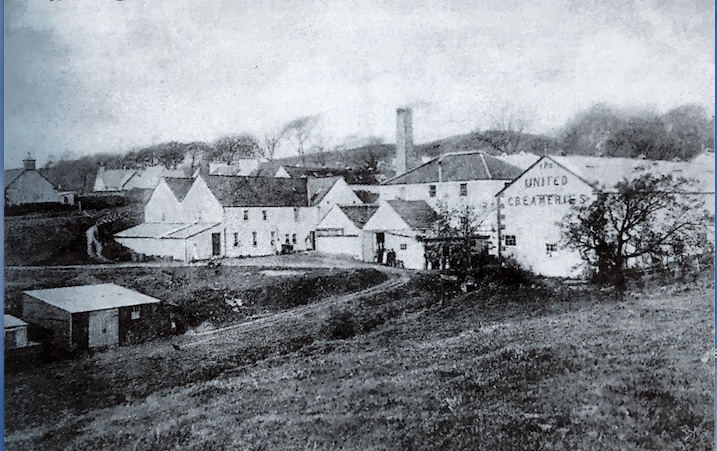
Dunragit Creamery (officially The Creamery Company) was established in 1882 as a private enterprise by Andrew Clement, a cheese factor in Glasgow and Robert McCracken, a Wigtownshire farmer, Andrew Clement was responsible for selling the product and and Robert McCracken was the general manager, and a butter expert from Denmark was responsible for the buttermaking. A. Gray in his book ‘White Gold’ records that the creamery was located in a dis-used farina mill, and it it is likely that this is the building in the above photo. (A farina mill turned surplus potatoes into a flour – farina – for human comsumption.)
At its entrance were the offices and the receiving department, where the milk supplied by the local farmers was weighed and recorded. An 1891 account records that the entrance was besieged every morning for three hours by an array of horse-drawn, two-wheeled farmers’ carts and four-wheeled, covered ‘spring vans’, which delivered a quantity of milk varying from 3,500 to 4,500 gallons daily.
From the weighing machines the milk then passed to the vat-room, where it was stored in large containers of 800 gallons capacity; from these vats the milk was conveyed by tin-lined pipes to the warmers, and thence to the centrifugal cream separators.
Part of the cream was made exceptionally thick, and after being thoroughly chilled, was put into neat little earthenware jars carefully sealed for despatch to the cities every afternoon. This cream, which kept sweet for at least fourteen days.
The remainder of the cream was used for making fresh butter.
The butter, after being weighed into half-pounds, was shaped into round and square patterns for different markets, and finally packed into large boxes which were sent to Glasgow, Edinburgh, and other large towns by the evening train. (Dunragit Creamery lay on the line of the Portpatrick and Wigtownshire Joint Railway to the west of its junction with the G&SWR line at Challoch).
During winter the separated milk, after coming from the centrifuge, was first carefully scalded and then thoroughly chilled by being passed over large capillary refrigerators to enhance its keeping qualities, and then filled into cans for consumption in the cities — milk sent to Glasgow and Edinburgh being in time for evening delivery to consumers, while that sent to the English towns was in good time for early morning use.
During summer, when there was little demand for separated milk, cheese was made, one of the specialities of the Company and for which there was always demand.
Surprisingly perhaps, the most important part of the Company’s business was the manufacture of margarine.
The Creamery Company later became known as United Creameries Limited when it was amalgamated with the Valleyfield Dairy Company in Kirkcudbrightshire, known as the Tarff Creamery. The merger also included Sorbie and Colfin in Wigtownshire, Kirkmichael in Ayrshire and Campbeltown in Argyllshire.
